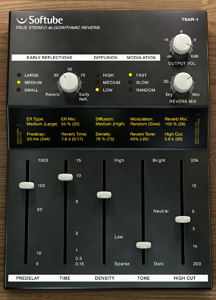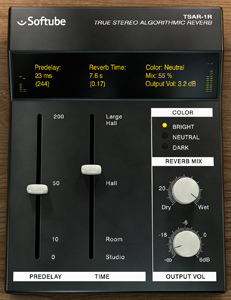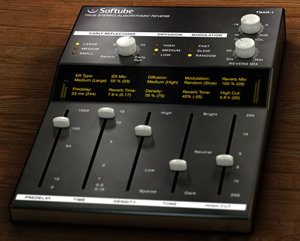Softube TSAR-1(R) Reverb Reviewed by Bo Boddie
Reverb. In the early days of the all-inclusive DAW the poor quality of reverberation plug-ins were always high on the list (a long list) of a given engineer’s complaints. In fact, the poor quality reverb of early plug-ins was enough to dissuade anyone from mixing in the box.
I remember the first mix I had to do in this manner, and, dissatisfied with results I was getting, snuck into a studio where I could print reverb stems with a 480L.
Even today, people who are truly serious about the quality of their ambience will opt for a dedicated hardware unit over a plug-in. The reasoning is simple: A breathtaking and convincing reverberation algorithm is incredibly complex and processor intensive, especially to keep its decay long and compelling. A unit with DSP specifically dedicated to powering this complex coding will do it better. The usual complaints about outboard gear will come up here, however, expense and ease of recall probably being the most common.
Today, there are some great reverb plug-ins out there, stuff that I use every day and am very happy with. Always on the lookout for more-more-more I was only too happy to check out Softube’s latest offering to the world of digital ambiance. The TSAR-1 ($329.00) and its simpler, bundled compatriot the TSAR-1R are unique in that they sound excellent, are simple to use, and do not consciously emulate anything that already exists.
In Softube speak, TSAR stands for True Stereo Algorithmic Reverb. Interestingly, this moniker highlights a return to ground-up coding of reverb algorithms, as opposed to the convolution trend over recent years, which involves sampling impulse responses of specific spaces and/or various pieces of gear. Not to say that there is anything wrong with the convolution “model,” it works well and sounds good. However, it is nice to be the beneficiary of a ground-up design that focuses more on new and interesting sounds and less so on the emulation of classic rooms and gear.
All this said, the TSAR-1(R) is an awesome contender. It sounds excellent on everything, and has a wide degree of tonal characteristics available with incredible ease of use, with a control set similar to the AMS RMX or Klark-Teknik DN-780.
The TSAR-1’s GUI features a more modern set up of 5 sliders, three knobs, and 9 buttons, and it doesn’t get any deeper than what you see on the surface — the functionality is obvious and impressive.
Adjusting the tone, density, and high-cut faders alone will yield you a huge variety of ambient colors, and they sound incredibly believable. I found this to be so especially with the shorter reverb times, where I’ve often lamented the difficulty that exists in adding a small amount of believable space to a sound.
TECH SPECS
As noted above, the TSAR-1 GUI is very simple and intuitive. The main controls are five sliders:
1. Pre-delay, from 0 to 1000 msecs.
2. Time, with reverberation times from 0.15 to 15 seconds.
3. Density, from “sparse” to “high”.
4. Tone, from “dark” to “bright”
5. High cut, from 200 Hz up to 20 kHz.
With the exception of the Density control, there are no mysteries here, and once you have toggled the density slide from sparse to high it is very easy to understand what is going on. It’s an interesting control in that it can be used to either fit reverberation into a densely populated background, or add a flimsier, vintage-y character to a reverberation that is more featured.
As the control gets closer to the sparse setting it gets much easier to hear the delays that are making up the reverberation.
Along with the slider controls there are several buttons and knobs divided into three sections. The Early Reflection section allows the user to choose either small, medium or large early reflection models, and then, using an adjoining knob, blend the reflections with the reverb to taste. The Diffusion and Modulation sections are even simpler, offering high, medium and low; and fast, slow, and random settings respectively.
There is also an output volume and a mix knob, which can be useful for instances of the plug-in which aren’t set up as auxiliaries.
Above the slider section there is a feedback screen which lists all the settings of the unit at a glance, a nice feature which gives a more precise reading of where the knobs and faders are actually set.
Finally, there is a nice set of 41 included presets, which can be great jumping off points. Some are nicely labeled with clues like “224,” “AMS,” or “EMT,” which gives a good clue as to what they might sound like…and surprisingly…they do sound quite similar!
Included with the TSAR-1 is its little brother, the TSAR-1R. Its control set is much simpler featuring only sliders for pre-delay and reverb time, a color section, and the knobs for mix and output level. The same reverb algorithm is used, however, there is a little less control. I’m not sure that there is much of an advantage processor-wise here, as it seems to be more geared towards ease of use without loss of sound quality.
IN USE, IN SUMMARY
After installing the TSAR-1 it immediately became my go-to reverb and I used it whenever I needed some ambience. A smooth plate for a vocal, medium sized room for a snare drum, sparkly string ambience; it really sounds great on everything. The control set is fantastic and it is very easy to quickly tweak the EQ of the reverb or time the pre-delay.
As I mentioned before, I found it really compelling when using short reverb times, it always sounded very natural, and didn’t exhibit any of the unrealistic slap-back one often encounters with some other reverb plugs.
When you take the price into consideration — $329 — this plug-in is a fantastic bargain and I highly recommend it if you are looking for a really high quality sound without spending an arm and a leg. Check out Softube’s homepage for the TSAR-1 and you’ll be able to check out some nice audio demos of the plug-in in action.
If you so desire you can also download a fully operational demo that will be active for 20 days, but be warned you will inevitably find yourself purchasing the iLok asset when the demo period is up!
Next up I’ll be looking at Softube’s emulation of the classic Valley People Dyna-mite, and given the quality of the TSAR-1 I’m excited to do so! Stay tuned…
Bo Boddie is a Grammy winning engineer/producer and composer who has worked with Santana, Everlast, Korn, Reni Lane, and many others. He is currently beginning work on Imperial Teen’s second release on Merge Records.
Please note: When you buy products through links on this page, we may earn an affiliate commission.










